#baroqueart
Text

NARCISSUS (c.1599) by CARAVAGGIO
NARCISSUS is one of the most famous GREEK mythological figures. He was a hunter who fell in love with a reflection of himself. When NARCISSUS realized he could not possess the image he had fallen in love with, he died of despair and turned into a flower.
CARAVAGGIO'S portrait of the GREEK mythological figure NARCISSUS uses his signature tenebrism (extreme contrasts between light and shade) and isolation to create a captivating image of the final act of the story of NARCISSUS
In many of NARCISSUS' other paintings, artists depict the landscape of the forest, sometimes with animals or other human-like creatures in the background. However, CARAVAGGIO strips away all but the pool of water from the story’s setting. Instead, he focuses on NARCISSUS himself, mirroring NARCISSUS’ own enchantment by his image.
In contrast to the black background that obscures the netherworld, the GREEK hunter is painted with bright colours and illuminated by the spotlight. Just like he is captivated by his reflection, the viewer can only be captivated by him.
The darkness of the water that NARCISSUS stares into is a sign of his coming doom. His face is hard to read in the reflection, as if the water, deceptive as it is, is not a place for a man to live or love. While one of NARCISSUS’ hands is placed on the ground, though dangerously close to the water, his other hand dares to touch his reflection.
When NARCISSUS leans towards the body of water, his calm face conveying the state of hypnosis he has fallen into, the viewer perceives a threat to come, even if there is no external threat.The danger is within NARCISSUS himself, and as he sits isolated from the world, he too will die isolated from the world.
18 notes
·
View notes
Photo

Interview: Dr. Bastian Eclercy on Guido Reni at the Städel Museum, Frankfurt
Misunderstood, neglected, forgotten. The Städel Museum in Frankfurt, Germany is
rediscovering one of the star painters of the Italian Baroque in a landmark exhibition: GUIDO RENI. The Divine. In his day, Reni (1575-1642) was one of the most successful and celebrated painters in all of Europe, coveted by the most important patrons, including the Borghese Pope Paul V, the Duke of Mantua, and the Queen of England. In this interview, James Blake Wiener speaks to curator Dr. Bastian Eclercy about the exhibition and Guido Reni’s brilliance as one the greatest artists of the Baroque era.
Learn more about Interview: Dr. Bastian Eclercy on Guido Reni at the Städel Museum, Frankfurt
29 notes
·
View notes
Text
The Entombment of Christ

Michelangelo Merisi da Caravaggio, The Entombment of Christ (1603-04). Oil on canvas, 300 × 203 cm. Pinacoteca Vaticana, Vatican City.
Michelangelo Merisi da Caravaggio's The Entombment of Christ, painted between 1603-04, stands as a testament to the artist's mastery of chiaroscuro and his ability to infuse religious subjects with raw emotion and intense realism. In this analysis, we delve into the compelling narrative and artistic techniques that make The Entombment of Christ a cornerstone of Baroque art.
The Drama of Grief and Devotion:
The Entombment of Christ captures the poignant moment of Christ's body being lowered into the tomb after the crucifixion. Caravaggio's composition draws the viewer into the scene, where figures mourn and console one another amidst the harsh realities of death. The central figure of Christ, with his lifeless body, becomes the focal point of the painting, surrounded by grieving disciples and mourners. Caravaggio's portrayal eschews idealized depictions, opting instead for a visceral and emotionally charged scene that resonates with viewers on a deeply human level.
Chiaroscuro and its Emotional Impact:
Caravaggio's masterful use of chiaroscuro, the contrast between light and dark, heightens the emotional intensity of The Entombment of Christ. Deep shadows and stark highlights create a sense of depth and drama, emphasizing the weight of grief and the solemnity of the moment. The interplay of light and shadow draws attention to the figures' expressions, casting them in a dynamic play of emotions that range from despair to quiet resignation.
Realism and Relatability:
One of Caravaggio's hallmarks is his commitment to realism, evident in the meticulous attention to detail and the lifelike portrayal of the human form in The Entombment of Christ. The figures' faces bear the marks of sorrow and exhaustion, their gestures and postures conveying a profound sense of loss and compassion. Caravaggio's ability to capture the human experience in all its complexity invites viewers to empathize with the scene and reflect on the universal themes of suffering, redemption, and hope.
A Testament to Caravaggio's Genius:
The Entombment of Christ exemplifies Caravaggio's revolutionary approach to art, characterized by his rejection of idealized conventions in favour of raw emotion and stark realism. The painting's impact lies not only in its technical brilliance but also in its ability to transcend the boundaries of time and culture, speaking to audiences across centuries with its timeless portrayal of human emotion and spirituality.
Engagement Question:
How does Caravaggio's portrayal of grief and devotion in The Entombment of Christ resonate with you personally, and what aspects of the painting do you find most compelling or thought-provoking?
#Caravaggio#BaroqueArt#ArtHistory#ItalianArt#Chiaroscuro#RealismInArt#ReligiousArt#DramaticRealism#EmotionalExpression#Masterpiece#ArtisticGenius#VisualNarratives#ArtCritique#ArtAnalysis#MuseumArt#ArtAppreciation#TheEntombmentOfChrist
4 notes
·
View notes
Text
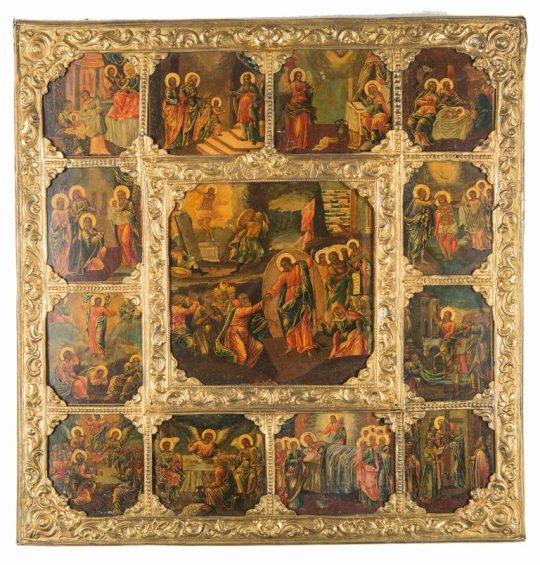
The featured antique icon of the Resurrection represents the Baroque style in Russian iconography. The shapes of heavily built figures, expressive colors, and natural motifs on a silver oklad are some of the visible traits of the movement. The icon was painted in Central Russia in the middle of the 18th century when Baroque started falling behind under the pressure of the Classical era. In some sense, this invaluable part of our collection is the remnant of the past glory. Find out more about its composition and the secrets of its oklad in our latest blog post.
#resurrectionofchrist#russianiconography#baroquestyle#baroqueart#religiousiconography#christ#jesus#jesuschrist#18thcentury#18century#russianiconcollection#religiousart#russianicons
20 notes
·
View notes
Photo

The Archduke Leopold Wilhelm in his Painting Gallery in Brussels, David Teniers the Younger, 1651. #davidteniers #davidtenierstheyounger #flemishbaroque #flemishbaroqueart #baroque #baroqueart #baroquestyle #flemishart #flemishpainting #flemishart #flemishartist #art #artwork #artist #archdukeleopoldwilhelminhisgallery #17thcentury #17thcenturyart #arthistory #artdetails #museodelprado #brussels #titian #giorgione #veronese #tintoretto #peterpaulrubens #raphael #jangossaert #parisbordone #palmavecchio #anthonyvandyck (at Museo del Prado) https://www.instagram.com/p/CqBFwdIIGrl/?igshid=NGJjMDIxMWI=
#davidteniers#davidtenierstheyounger#flemishbaroque#flemishbaroqueart#baroque#baroqueart#baroquestyle#flemishart#flemishpainting#flemishartist#art#artwork#artist#archdukeleopoldwilhelminhisgallery#17thcentury#17thcenturyart#arthistory#artdetails#museodelprado#brussels#titian#giorgione#veronese#tintoretto#peterpaulrubens#raphael#jangossaert#parisbordone#palmavecchio#anthonyvandyck
7 notes
·
View notes
Photo
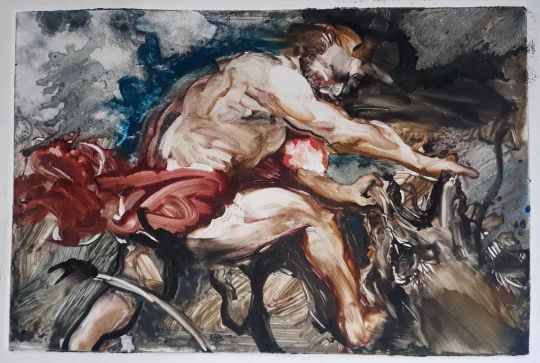
Monotype study, homage to Rubens, 12" x 18" #monotype #printmaking #monotypeprint #painterlyprint #uniqueprint #homage #rubens #samson #allegoricalart #ink #baroqueart #expressionistart #brooklynartist https://www.instagram.com/p/CpgRQ98Oo6p/?igshid=NGJjMDIxMWI=
#monotype#printmaking#monotypeprint#painterlyprint#uniqueprint#homage#rubens#samson#allegoricalart#ink#baroqueart#expressionistart#brooklynartist
4 notes
·
View notes
Photo

I painted this a while ago after being inspired by the original painting "Armida Abandoned by Rinaldo" from Giambattista Tiepolo, dated 1742/45. . . . #armida #armidaabbandonata #armidaabandonedbyrinaldo #myart #miarte #artista #pintura #baroque #baroqueart #realism #realismart #impressionism #arte #dibujo #delorenzoART #giambattista #giambattistatiepolo #italianart #paintingart #seniorartist #seniorartistry https://www.instagram.com/p/CnK0mLmOlp4/?igshid=NGJjMDIxMWI=
#armida#armidaabbandonata#armidaabandonedbyrinaldo#myart#miarte#artista#pintura#baroque#baroqueart#realism#realismart#impressionism#arte#dibujo#delorenzoart#giambattista#giambattistatiepolo#italianart#paintingart#seniorartist#seniorartistry
6 notes
·
View notes
Text


Piazza di Trevi & Vicolo Lucchesi, Trevi. Rome, Lazio, Italy.
#italy#italia#rome#roma#romephoto#romephotography#romephotographer#italianstyle#italiandesign#italianarchitecture#trevi#trevi fountain#italian#baroque#baroqueart#sculpture#art#artphoto#artphotography#italianart#cityofrome#romecenter#street#streetphoto#streetphotography#streetphotographer#city#canon#50mm#léo cadra
5 notes
·
View notes
Photo

The snow on the Royal Palace of Caserta highlights the violin designed by Vanvitelli. @campaniasvelata #campania #reggiadicaserta #caserta #napoli #italy #vanvitelli #baroque #baroquemasterpiece #masterpiece #baroquearchitecture #baroqueofficial #baroquestyle #baroqueart #campania_super_pics #campaniadascoprire #campania_cartoline #campaniainfoto #campania_lovers #visitcampania (presso Campania, Italy) https://www.instagram.com/p/CliXrssM5kD/?igshid=NGJjMDIxMWI=
#campania#reggiadicaserta#caserta#napoli#italy#vanvitelli#baroque#baroquemasterpiece#masterpiece#baroquearchitecture#baroqueofficial#baroquestyle#baroqueart#campania_super_pics#campaniadascoprire#campania_cartoline#campaniainfoto#campania_lovers#visitcampania
4 notes
·
View notes
Photo
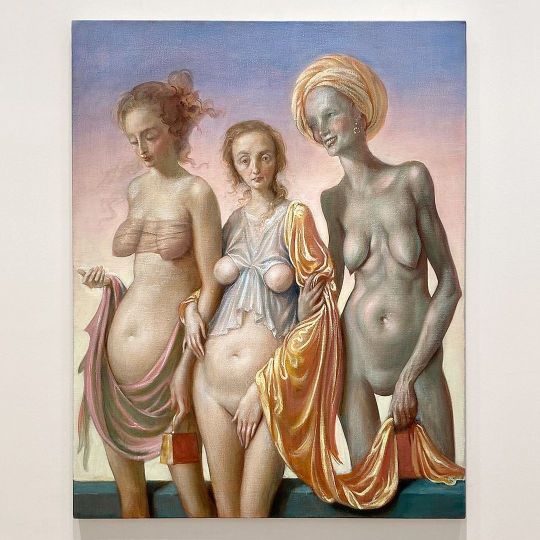
John Currin at Sadie Coles, London. Here • Gala • from 2022. What is it with John Currin? Why is it that he has raised hackles since his 1992 debut? Now, but even then, people wondered if his pictures of women should be regarded as acceptable. His crazy, but in my opinion brilliant Gagosian show, hit a big nerve last year. Again, a group of people responded angry, even to the point that some talking about the work was evil and should be boycotted… Sadie Coles shows three of his latest paintings. What do you make out of it? #contemporyart #art #artist #painter #painting #oil #canvas #fashion #vanitas #muse #allegory #storytelling #mythological #baroque #baroqueart #religious #renaissance #renaissanceart #arthistory #portrait #portraiture #figurative #figuration #figurativeart #theamazingpoppingeyes #london https://www.instagram.com/p/ClPLMFxLX6X/?igshid=NGJjMDIxMWI=
#contemporyart#art#artist#painter#painting#oil#canvas#fashion#vanitas#muse#allegory#storytelling#mythological#baroque#baroqueart#religious#renaissance#renaissanceart#arthistory#portrait#portraiture#figurative#figuration#figurativeart#theamazingpoppingeyes#london
2 notes
·
View notes
Photo

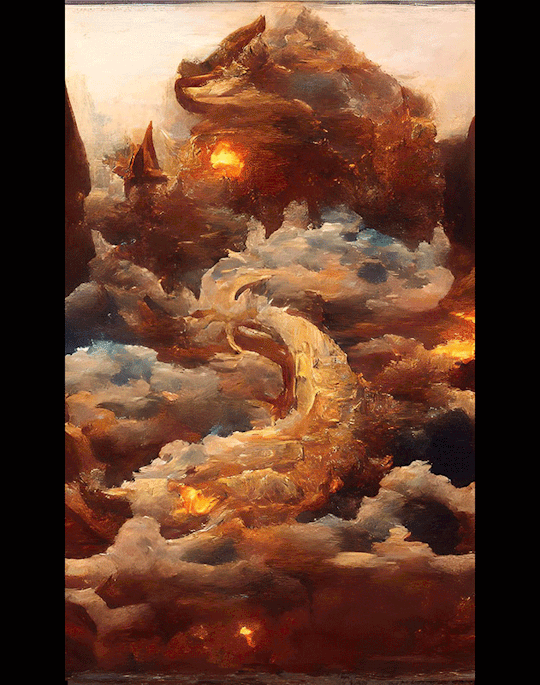
Into the Fire - Smaugust 11
Face the mighty guardian of the old chapel to gain the holy secrets kept there. Some say the beast ruined it in time immemorial, but those that returned swore on its benevolence.
I was prompting WOMBO Dream on "Baroque" style for this one, using an initial image made in Disco Diffusion that didn't quite work out like I wanted. But the style worked nicely so I tried to carve the initial shape out of the classic-oil-painting-mush-of-browns. It was actually hard to get close to the typical surface details like uneven, dirty brushstrokes and tiny highlights from thick varnish, but Painter helped with its Impasto brushes that I rarely ever use otherwise. So in the end, this was mostly an exercise in painting, short as I kept it.
See a timelapse GIF on Artstation, https://www.artstation.com/artwork/kl8xPn
3 notes
·
View notes
Text
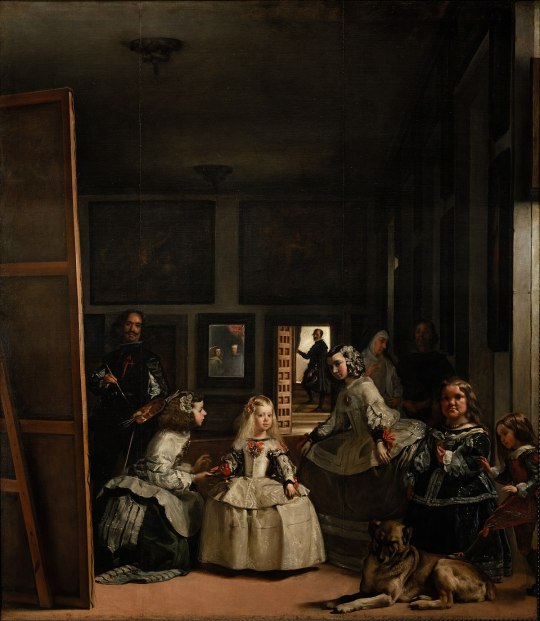
LAS MENINAS (1656) by DIEGO VELÁZQUEZ
The title translates to “Maids of Honour”. In the painting, INFANTA MARGARITA sits in VELAZQUEZ’S large studio surrounded by her ladies-in-waiting and other courtiers. She is five years old and the heir to the throne of SPAIN.
The large painting also shows Velazquez himself standing behind a huge canvas on the left-hand side. The strong, foreshortened, right-hand wall has three rows of artworks that help define the space. Over half of the room is dark, dim, and vacant around the figures. On the back wall, the royal couple is reflected in a mirror.
In the lower right-hand corner are two court dwarves and a large dog. Behind the dwarves are two women, one a nun and one a lady’s guard. The queen’s quartermaster can be seen on the steps at the back, facing an open sunlit door.
Technically speaking, the piece is proof of VELAZQUEZ’S genius when it comes to composition. Here, he employed astute observation to create compelling portraits, but the real focus of the work, utilizing real space, mirror space, and pictorial space, is its almost modern play upon perception itself.
He used his subjects’ positioning to create multiple planes of view and diagonals that draw the viewer’s attention to different parts of the room in an even manner. We’re not only guided to see what’s going on in the room but also to think about what’s beyond the boundaries of what we see.
14 notes
·
View notes
Photo
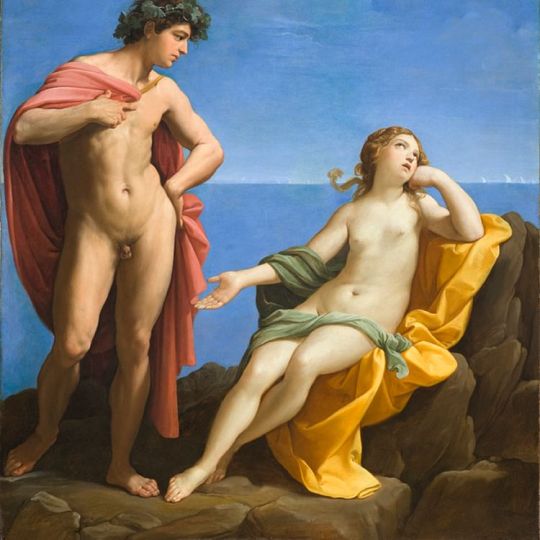
Interview: Dr. Bastian Eclercy on Guido Reni at the Städel Museum, Frankfurt
Misunderstood, neglected, forgotten. The Städel Museum in Frankfurt, Germany is
rediscovering one of the star painters of the Italian Baroque in a landmark exhibition: GUIDO RENI. The Divine. In his day, Reni (1575-1642) was one of the most successful and celebrated painters in all of Europe, coveted by the most important patrons, including the Borghese Pope Paul V, the Duke of Mantua, and the Queen of England. In this interview, James Blake Wiener speaks to curator Dr. Bastian Eclercy about the exhibition and Guido Reni’s brilliance as one the greatest artists of the Baroque era.
Continue reading...
33 notes
·
View notes
Photo

Recently painted details. Working hard toward our exhibition @not___today___satan at @baerumkunsthall in October! #painting #oilpainting #oilpaint #oiloncanvas #workinprogress #wip #masterstudy #mastercopy #rubens #peterpaulrubens #sirpeterpaulrubens #massacreoftheinnocent #thescapegoat #violenceandthesacred #mimeticdesire #mimetictheory #renegirard #baroqueart #baroquepainting #baroque #flemishbaroque #flemishpainting #arthistory #christianart #religiousart #religiouspainting #nottodaysatan https://www.instagram.com/p/CiD-bB0quR3/?igshid=NGJjMDIxMWI=
#painting#oilpainting#oilpaint#oiloncanvas#workinprogress#wip#masterstudy#mastercopy#rubens#peterpaulrubens#sirpeterpaulrubens#massacreoftheinnocent#thescapegoat#violenceandthesacred#mimeticdesire#mimetictheory#renegirard#baroqueart#baroquepainting#baroque#flemishbaroque#flemishpainting#arthistory#christianart#religiousart#religiouspainting#nottodaysatan
2 notes
·
View notes
Text
Judith Slaying Holofernes

Artemisia Gentileschi, Judith Beheading Holofernes (1620). Oil on canvas, 146.5 x 108 cm. Museo Capodimonte, Naples.
Artemisia Gentileschi's Judith Slaying Holofernes stands as one of the most vivid and dramatic works in the realm of Baroque painting, encapsulating themes of courage, justice, and female empowerment. This post delves into the artistic and symbolic nuances of Gentileschi’s iconic painting, offering a deep dive into its historical context, visual analysis, and enduring impact.
The Power and Fury: A Closer Look at Gentileschi's Masterpiece
Artemisia Gentileschi, born in 1593 in Rome, was one of the first women to achieve recognition in the male-dominated world of post-Renaissance art. Judith Slaying Holofernes is often viewed through the lens of Gentileschi's personal history, particularly her experience with sexual assault and the subsequent highly publicized trial. The painting, created in the early 1620s, is interpreted by many as a form of cathartic expression, showcasing her mastery over her traumas and her assailants.
The Art of Contrast: Tenebrism in Judith Slaying Holofernes
The painting depicts the biblical story of Judith, a widow who saves her village from the Assyrian general Holofernes by seducing and then beheading him. Gentileschi’s rendition is remarkable for its intense realism and emotional power. Unlike other contemporary versions of the subject, Gentileschi’s Judith appears strong and resolute in her task, capturing a moment of intense physical and psychological action.
Defiance in the Details: Symbolism in Gentileschi's Narrative
In Judith Slaying Holofernes, Gentileschi aligns herself with Judith, symbolically enacting a narrative of female agency and vengeance. This work is often read as a proto-feminist statement, with Judith’s act representing a broader defiance against patriarchal oppression. The painting challenges traditional gender roles and reflects Gentileschi's own struggles against the societal limitations imposed on women of her time.
Artemisia Gentileschi's Legacy: Reclaiming Space and Narrative
Artemisia Gentileschi's work has experienced a resurgence of interest in recent years, celebrated for its bold thematic content and its reflection of the artist's personal narrative of overcoming adversity. Judith Slaying Holofernes not only contributes to the historical narrative of art but continues to inspire discussions on gender, power, and resilience.
A Canvas of Courage: The Timeless Message of Judith Slaying Holofernes
Judith Slaying Holofernes by Artemisia Gentileschi is not just a depiction of a biblical heroine, but a profound commentary on justice, courage, and the capabilities of women both in art and in life. It remains a powerful image of defiance and autonomy, resonating with audiences centuries after it was painted.
Reflect and Engage
How do you think Judith Slaying Holofernes challenges or reinforces the perceptions of women both in the era it was painted and today? Does the painting's violent imagery detract from or enhance its message of female empowerment?
#ArtemisiaGentileschi#JudithSlayingHolofernes#BaroqueArt#FeministArt#ArtHistory#WomenInArt#PowerfulPaintings#ArtisticExpression#HistoricalArt#ArtAndResistance#artblogger
0 notes
Photo

James II of England, then Duke of York, Henri Gascar, 1673. #henrigascar #henrigascard #art #artwork #artist #oiloncanvas #oiloncanvaspainting #oiloncanvasportrait #portrait #painting #jamesii #jamesiiofengland #dukeofyork #17thcentury #17thcenturyart #baroque #baroqueart #baroquepainting #roman #costume #mars #godofwar #silk #armour #frenchartist #frenchart #frenchpainter #royalcollection #nationalmaritimemuseum #london (at National Maritime Museum) https://www.instagram.com/p/CmR85AUIoz4/?igshid=NGJjMDIxMWI=
#henrigascar#henrigascard#art#artwork#artist#oiloncanvas#oiloncanvaspainting#oiloncanvasportrait#portrait#painting#jamesii#jamesiiofengland#dukeofyork#17thcentury#17thcenturyart#baroque#baroqueart#baroquepainting#roman#costume#mars#godofwar#silk#armour#frenchartist#frenchart#frenchpainter#royalcollection#nationalmaritimemuseum#london
15 notes
·
View notes